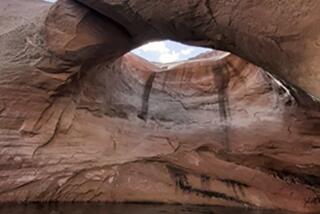Bowed and Now Broken
- Share via
The gnarled old tree was an improbable thing, growing out of nearly seamless granite. For as long as 400 years it had survived the storms that lashed the Sierra Nevada. The weathered trunk was bent nearly horizontal, like an ancient man who had borne too much of a burden too long. Its naked gray branches, long stripped of needles and bark, bowed toward the rock beneath them as if seeking to prop the old tree up. But the famed Jeffrey pine atop 8,122-foot Sentinel Dome in Yosemite National Park finally toppled this month.
The tree first gained wide attention when it was captured on glass plates by pioneer photographer Carleton Watkins in 1867. Spurred by an elegant shot by Ansel Adams in 1940, Yosemite visitors hiked the 2.4-mile round trip from the Glacier Point Road to see the tree and photograph it themselves with their Brownies, Nikons, point-and-shoots or digitals. It was one of the most famous trees in the nation, framing a commanding view of Half Dome to the east and the Yosemite high country beyond and Yosemite Valley below it to the north. Not a massive oak or soaring redwood, the little pine still acquired a measure of sublime grace.
No one is certain how the tree took root in its isolated spot atop the granite dome, spare of other vegetation except lichen and stunted alpine shrubbery. Most likely a seed dropped by a bird found its way into a crack filled with soil that collected virtually grain by grain as the granite weathered.
The tree died in the 1976-77 drought even though park rangers and others tried to keep it alive by hauling in buckets of water. Still, it stayed upright -- as much as a wind-stooped tree could -- for three more decades. Park officials believe the tree finally fell about Aug. 10 after storms raked the Sierra the week before.
The image of the tree is so marked in the mind’s eye of those who saw it in person or in the famous photographs that it’s hard to grasp that the pine is now just a jumble of sticks. But that is the natural process that the national parks showcase so well.
In Yosemite especially, evolution involved eons of glacial carving that created the incomparable valley and its stately domes, combined with the rain, snow, burning sun and wind that caused the famed Jeffrey pine to take root, to thrive and ultimately to fall back to the rock.
More to Read
Sign up for Essential California
The most important California stories and recommendations in your inbox every morning.
You may occasionally receive promotional content from the Los Angeles Times.













